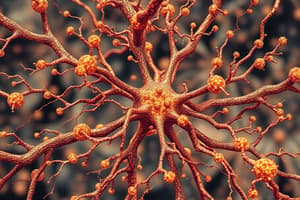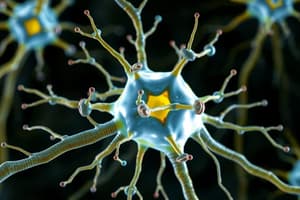Podcast
Questions and Answers
What is the primary function of GABA in the central nervous system?
What is the primary function of GABA in the central nervous system?
- Stimulation of neuronal excitability
- Inhibition of nerve transmission (correct)
- Regulation of reward and pleasure
- Control of parasympathetic functions
A deficit in dopamine is related to which of the following conditions?
A deficit in dopamine is related to which of the following conditions?
- Alzheimer's disease
- Parkinson's disease (correct)
- Depression
- Epilepsy
Which neurotransmitter is identified as the principal excitatory neurotransmitter in the CNS?
Which neurotransmitter is identified as the principal excitatory neurotransmitter in the CNS?
- Acetylcholine
- Serotonin
- Dopamine
- Glutamate (correct)
What is the role of acetylcholine concerning muscle control?
What is the role of acetylcholine concerning muscle control?
Too little serotonin is commonly associated with which condition?
Too little serotonin is commonly associated with which condition?
Which function is primarily associated with the rubrospinal tract?
Which function is primarily associated with the rubrospinal tract?
Where does the tectospinal tract decussate?
Where does the tectospinal tract decussate?
How many neurons are involved in the reticulospinal tract pathway?
How many neurons are involved in the reticulospinal tract pathway?
What is the primary role of the reticulospinal tract?
What is the primary role of the reticulospinal tract?
What type of movements does the tectospinal tract primarily facilitate?
What type of movements does the tectospinal tract primarily facilitate?
Which cell type in the granular layer is responsible for inhibitory neurotransmission?
Which cell type in the granular layer is responsible for inhibitory neurotransmission?
What is the primary role of the Dentate Nucleus?
What is the primary role of the Dentate Nucleus?
Which neurotransmitter is commonly released by Climbing Fibers?
Which neurotransmitter is commonly released by Climbing Fibers?
In neural sharpening, what phenomenon occurs to neuron firing rates?
In neural sharpening, what phenomenon occurs to neuron firing rates?
Which structure represents the appendicular skeleton within the cerebellar organization?
Which structure represents the appendicular skeleton within the cerebellar organization?
Which of the following statements about Stellate Cells is true?
Which of the following statements about Stellate Cells is true?
Which of the following layers contains the somas of Purkinje Cells?
Which of the following layers contains the somas of Purkinje Cells?
What is the function of Granule Cells in the cerebellum?
What is the function of Granule Cells in the cerebellum?
What term is used to describe the difficulty in performing rapid alternating movements?
What term is used to describe the difficulty in performing rapid alternating movements?
Which condition is characterized by a wider-base gait and difficulty in tandem gait?
Which condition is characterized by a wider-base gait and difficulty in tandem gait?
In which direction do the fast phases of nystagmus typically move in relation to a cerebellar lesion?
In which direction do the fast phases of nystagmus typically move in relation to a cerebellar lesion?
What occurs during the Rebound Phenomenon when a patient abruptly stops resisting force?
What occurs during the Rebound Phenomenon when a patient abruptly stops resisting force?
How many pairs of spinal nerves are present in the human body?
How many pairs of spinal nerves are present in the human body?
From which part of the spinal cord do sensory neurons primarily receive information?
From which part of the spinal cord do sensory neurons primarily receive information?
Which spinal nerves exit the vertebral column above their corresponding vertebrae?
Which spinal nerves exit the vertebral column above their corresponding vertebrae?
What does scanning speech indicate?
What does scanning speech indicate?
What type of paralysis is characterized by spastic paresis?
What type of paralysis is characterized by spastic paresis?
What is the primary effect of anterior spinal artery syndrome on sensory pathways?
What is the primary effect of anterior spinal artery syndrome on sensory pathways?
Which syndrome is directly associated with compression in the cauda equina?
Which syndrome is directly associated with compression in the cauda equina?
What common clinical presentation is associated with tabes dorsalis?
What common clinical presentation is associated with tabes dorsalis?
In which condition would you expect to see both upper and lower motor neuron lesions?
In which condition would you expect to see both upper and lower motor neuron lesions?
Which reflex is expected to be absent in lower motor neuron syndrome?
Which reflex is expected to be absent in lower motor neuron syndrome?
What is a typical motor response in Central Cord Syndrome?
What is a typical motor response in Central Cord Syndrome?
Which vascular structure supplies the posterior spinal cord?
Which vascular structure supplies the posterior spinal cord?
What leads to cape-like loss of pain and temperature sensation?
What leads to cape-like loss of pain and temperature sensation?
What is a hallmark of Brown Sequard Syndrome?
What is a hallmark of Brown Sequard Syndrome?
Flashcards are hidden until you start studying
Study Notes
Neurotransmitters and Their Functions
- Specific receptors must be present on postsynaptic cells for neurotransmitter action.
- Acetylcholine: Essential for somatic muscle control and parasympathetic functions; deficits linked to Alzheimer's and Myasthenia Gravis.
- Dopamine: Involved in reward and movement regulation; deficits associated with Parkinson's disease.
- Glutamate: Principal excitatory neurotransmitter in the CNS; excess linked to epilepsy/seizures, crucial for learning and memory.
- GABA: Primary inhibitory neurotransmitter; low levels contribute to epilepsy/seizures and anxiety.
- Serotonin: Stabilizes mood and regulates sleep; deficits related to depression.
Cerebellar Cortex Layers
- Molecular Layer: Contains axons of granule cells, dendrites from Purkinje cells, and inhibitory stellate and basket cells.
- Purkinje Layer: Composed of a single layer of Purkinje cell bodies with extensive dendrites extending into the molecular layer.
- Granular Layer: Houses granule and Golgi cells, along with axons from mossy fibers.
Cerebellar Cell Types and Neurotransmitters
- Climbing Fibers: Release glutamate (excitatory) affecting Purkinje cells.
- Mossy Fibers: Use glutamate (excitatory) to influence granule and Golgi cells.
- Granule Cells: Also release glutamate (excitatory) impacting stellate and basket cells.
- Golgi Cells: Release GABA (inhibitory) affecting granule cells.
- Stellate and Basket Cells: Release GABA (inhibitory) on Purkinje cells.
- Purkinje Cells: Release GABA (inhibitory) impacting deep cerebellar nuclei.
Neural Sharpening Concept
- Neural sharpening enhances object recognition through repetition, associated with reduced neuron firing rates termed repetition suppression.
Cerebellar Homunculus
- Vermis: Represents axial skeleton (trunk, neck, head).
- Paravermis: Represents appendicular skeleton (limbs).
- Lateral Hemispheres: Represent posterior lobe functions.
Deep Cerebellar Nuclei
- Dentate Nucleus: Main output; involves fine control of voluntary movements, cognition, language, and sensory processing.
- Emboliform & Globose Nuclei: Functionally related to movement coordination.
- Fastigial Nucleus: Coordinates trunk, head, and neck movements.
Clinical Presentation of Cerebellar Dysfunction
- Balance problems and gait disorders (ataxia).
- Uncoordinated movements (dysmetria).
- Speech issues such as dysarthria.
- Visual disturbances (nystagmus) and symptoms of vertigo.
Specific Movement Disorders
- Dysdiadochokinesia: Difficulty with rapid alternating movements, may indicate MS or cerebellar issues.
- Scanning Speech: Individual syllables pronounced distinctly.
- Dysmetria: Assessed by nose-touch test; involves evaluation of movement smoothness.
- Ataxia: Symptoms include wide-based gait and impaired tandem walking.
Reflex and Motor Response Assessment
- Rebound Phenomenon: Examines spastic limb reactions when force is resisted and then abruptly stopped.
- Pronator Drift: Assesses upper limb motor function; sign of possible neurological issues if hand pronates.
Spinal Cord Anatomy and Function
- Dorsal Horn: Houses neurons for somatosensory information.
- Ventral Horn: Contains motor neuron bodies; associated with muscle control.
Spinal Nerves
- Total of 31 pairs; categorized into cervical, thoracic, lumbar, sacral, and coccygeal regions.
- All spinal nerves carry both sensory and motor functions.
- C1-C7 exit above vertebrae; all others exit below.
Blood Supply to Spinal Cord
- Anterior Spinal Artery: Supplies the anterior two-thirds.
- Posterior Spinal Arteries: Supply the posterior aspect; includes artery of Adamkiewicz.
Spinal Cord Lesions and Presentations
- Anterior Spinal Artery Syndrome: Loss of pain and temperature sensation with intact vibration.
- Tabes Dorsalis: Impairs dorsal columns; results in loss of vibration sense.
- Cauda Equina Syndrome: Leads to saddle anesthesia and bladder dysfunction.
- Spinothalamic Lesion: Causes contralateral loss of pain and temperature.
- Syringomyelia: Results in bilateral pain and temperature loss, often associated with Chiari malformation.
- Central Cord Syndrome: Characterized by cape-like loss of pain and temperature; common in elderly.
- Amyotrophic Lateral Sclerosis (ALS): Features both UMN and LMN lesions, leading to progressive motor neuron degeneration.
- Brown-Sequard Syndrome: Sudden unilateral spinal cord damage leads to specific sensory deficits on opposite sides of the body.
Studying That Suits You
Use AI to generate personalized quizzes and flashcards to suit your learning preferences.





